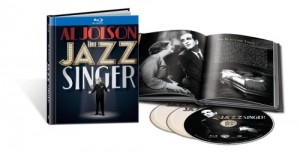This post contains affiliate links and our team will be compensated if you make a purchase after clicking on the links.
 If you’re reading this article, there’s a good chance that you already know that the Jazz Singer was the first instance of perfectly synchronized spoken dialogue. Stunned audiences gasped as star Al Jolson declared “you ain’t heard nothing yet” and filmmaking was changed forever. However, The Jazz Singer is such a milestone in the evolution of cinema, it is somewhat of a challenge to judge the film on it’s own terms rather than it’s historical significance.
If you’re reading this article, there’s a good chance that you already know that the Jazz Singer was the first instance of perfectly synchronized spoken dialogue. Stunned audiences gasped as star Al Jolson declared “you ain’t heard nothing yet” and filmmaking was changed forever. However, The Jazz Singer is such a milestone in the evolution of cinema, it is somewhat of a challenge to judge the film on it’s own terms rather than it’s historical significance.
When I received Warner Bros. stunning 3-Disc Blu-Ray, I quickly scanned the packaging for the extensive extras and realized that I wasn’t going to be able to tear myself away from the countless hours of history contained within. However, I also recall seeing clips of the actual film back in college, and being not only underwhelmed at how pedestrian the whole thing seemed, but shocked at the blatant racism. Believe it or not, this is a film containing exensive sequences of the lead character in blackface.
I have to commend Warner Bros. for not shying away from this disturbing aspect of their past. Included in the set is a beautifully put together book featuring a detailed history of the film, complete with photos, script pages, etc. The introduction to this book reads “While the following does not represent the Warner Bros. view of today’s society, this book presents views as they were originally created, because to do otherwise would be the same as claiming these prejudices never existed.” Absolutely perfect. I wish Disney would take a cue and finally acknowledge the black sheep of their film library, Song of the South. But I digress.
Having read through the book and put the racism of the film in it’s proper context, it was time to actually watch the movie itself. As I remembered, it doesn’t really hold up all that well. The story revolves around Jakie, a born entertainer whose father is adamant he become a Cantor as his lineage dictated. After a confrontation with his father, he ends up running away and becoming a huge success. Several years later, his father is dying and wants only for his son to sing Kol Nidre, a traditional declaration associated with Yom Kippur. Jakie is supposed to perform that night, but he honors his fathers wishes, they make peace as he dies, and the film ends with his family seeing him perform on stage.
To call the story simplistic would be an understatement. Having been adapted from a very popular stage show, I can’t understand why the story was so popular prior to the technological breakthrough. For that matter, I can’t understand why Al Jolson was such an exceptionally popular performer. Audiences adored Jolson, and he was considered one of the great entertainers of his time. I don’t find him bad at all. He brings an energy to all he does, and his musical numbers are slight but entertaining. It was really a different world back then, and people responded differently to different forms of entertainment. Knowing the thunderous applause and standing ovations every screening of this film received really puts into perspective how times have changed.
Warner Bros. has done a stupendous job providing that perspective with this box set. Practically a film-history class in a box, the actual film is but a small part of what is included in this set. As mentioned earlier, there is a fantastic book included with the set that not only summarizes the evolution of the industry that led to the breakthroughs in the film, but it includes an exact copy of the detailed program audiences received when they saw the film. The set is worth owning just for this book alone.
Additional content on the first disc includes a fascinating commentary track from film historian Ron Hutchinson and bandleader Vince Giordano, a collection of short films, including a surprisingly funny animated spoof of the Jazz Singer called “I Love to Singa” by Charles (or as he would come to be known, Chuck) Jones. One of the most unique short films on this disc is called “An Intimate Dinner in Celebration of warner Bros.’ Silver Jubilee,” a meta film before the concept of meta had been popularized. It featured actors playing concepts invovled in the evolution of the Warner Bros’ company, including a little girl playing “vitaphone,” the technology that made dialogue on film possible. “A Plantation Act,” the short film that brought Al Jolson to the forefront for this role, is also included. Fascinating as a piece of history, it’s also very uncomfortable to watch, as Jolson performs the entire short in blackface.
The second disc has less to do with The Jazz Singer specifically, and more about the actual history of sound in cinema. There is a full-length documentary called “The Dawn of Sound: How Movies Learned to Talk” that provides the most comprehensive analysis of the introduction of sound that I have seen. Chronicling the inventors, the evolution, and the ultimate impact of the technology, this is Must-See viewing for anybody with even a passing interest in the subject. Other extras on this disc include sound excerpts from “Gold Diggers of Broadway,” and several short films made by the studio that focused on the advent of sound. Some of these treat the subject humorously, including a very funny animated short featuring a conversation between two film reels, one a very vocal talkie and the other a subtitled silent film. Others treat the matter very seriously.
Finally, the third disc contains over 3 1/2 hours’ of Vitaphone comedy and music shorts. This disc is a goldmine of material for those with an interest in the history of the medium. I cannot emphasize enough how amazing this set is. Despite how flawless the film looks with it’s impeccably remastered transfer, I won’t be revisiting The Jazz Singer itself all that often. However, these Blu-Rays will get a lot of play over the years. Warner Bros. have truly outdone themselves with this one.
Discover more from Socalthrills.com
Subscribe to get the latest posts sent to your email.












